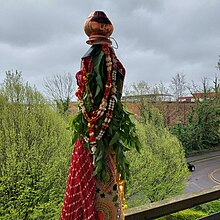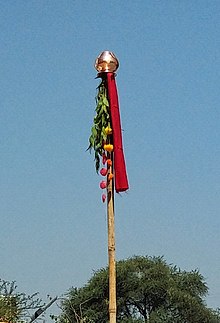|
Gudi Padwa
 Gudi Padwa is a spring festival marking the start of the lunisolar new year for Marathi and Konkani Hindus.[1] It is celebrated in and around Maharashtra, Goa & Damaon at the start of Chaitra, the first month of the lunisolar Hindu calendar. The festival is characterised by colourful floor decorations called rangoli, a special gudi dvaja; which is a saari or dhoti or other piece of cloth garlanded with flowers, mango & neem leaves; a sugar crystal garland called gathi, topped with upturned silver or copper vessels. Celebration also includes street gathering, dancing & festive foods.[1][2]  In Maharashtra, the first day of the bright phase of the moon is called gudhi paadwaa (Marathi: गुढी पाडवा), pādvo (Konkani: पाडयो; Kannada: ಪಾಡ್ಯ; Telugu: పాడ్యమి, paadyami). Konkani Hindus variously refer to the day as sausāra pāḍavo or sausāra pāḍyo (सौसार पाडवो and सौसार पाडयो, respectively).Kannada Hindus in Karnataka refer to it as [Ugadi]] (युगादि/ ಯುಗಾದಿ),while,Telugu Hindus celebrate the same occasion as Ugadi, [. Sindhi people celebrate the day as Cheti Chand, it is observed as the emergence of the day of Jhulelal. Prayers are offered to Jhulelal, and the festival is celebrated by making delicacies like tahiri (sweet rice) and sai bhaji.[3] However, this is not the universal new year for all Hindus. For some, such as those in and near Gujarat, the new year festivities coincide with the five-day Diwali festival.[4] For many others, the new year falls on Vaisakhi between 13 and 15 April, according to the solar cycle part of the Hindu lunisolar calendar and this is by far the most popular not only among Hindus of the Indian subcontinent but also among Buddhists and Hindus of Southeast Asia.[4] EtymologyGudi means 'flag'; according to Kittel, the term is of South Indian origin.[5] The word pāḍavā is derived from the Sanskrit word pratipad for the first day of each fortnight in a lunar month, or the first day on which the moon appears after the "new moon" day (amāvāsya) and the first day after the full moon. A Gudhi is also hoisted on this occasion, gives this festival its name. The term padva or padavo is also associated with Balipratipada.[6] SignificanceGudi Padva signifies the arrival of spring and the reaping of rabi crops.[7] The festival is linked to the day on which the Hindu god Brahma created time and the universe.[8] To some, it commemorates the coronation of Rama in Ayodhya after his victory over Ravana, or the start of the Shalivahan calendar after he defeated the Huns in the first century.[9] According to Anne Feldhaus, in rural Maharashtra, the festival is linked to Shiva's dance and the coming together of the community as they carry the Gudi Kavads together to a Shiva temple.[10] The guḍhīDuring Gudi Padwa, gudi (or gudhi) are arranged at every household. It is a bright, colorful silk scarf-like cloth tied at the top of a long bamboo. On top of it, one or more boughs of neem and mango leaves are attached with a garland of flowers. It is capped with a silver, bronze, or copper pot (handi or kalash), signifying victory or achievement.[11][12] Some temples are located on the top of hills, and groups work together to help reach the kavad to the top.[12]  Some of the significances attributed to raising a gudi are as follows:[7]
Festivities Traditionally, families prepare a special dish that mixes various flavours, particularly the bitter leaves of the neem tree and sweet jaggery (gur, gul). Additional ingredients include sour tamarind and astringent dhane seeds. This, like the pacchadi recipe used in Ugadi festival, is eaten as a reminder of life's sweet and bitter experiences and a belief that the neem-based mixture has health benefits.[11][13] Other namesThe festival is also known as[14]
See also
References
|
||||||||||||||||||||||||||||||||||||||||||||


